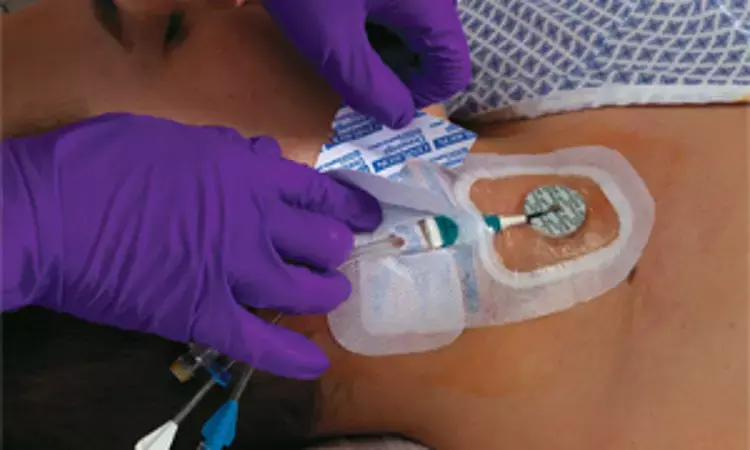- Home
- Medical news & Guidelines
- Anesthesiology
- Cardiology and CTVS
- Critical Care
- Dentistry
- Dermatology
- Diabetes and Endocrinology
- ENT
- Gastroenterology
- Medicine
- Nephrology
- Neurology
- Obstretics-Gynaecology
- Oncology
- Ophthalmology
- Orthopaedics
- Pediatrics-Neonatology
- Psychiatry
- Pulmonology
- Radiology
- Surgery
- Urology
- Laboratory Medicine
- Diet
- Nursing
- Paramedical
- Physiotherapy
- Health news
- Fact Check
- Bone Health Fact Check
- Brain Health Fact Check
- Cancer Related Fact Check
- Child Care Fact Check
- Dental and oral health fact check
- Diabetes and metabolic health fact check
- Diet and Nutrition Fact Check
- Eye and ENT Care Fact Check
- Fitness fact check
- Gut health fact check
- Heart health fact check
- Kidney health fact check
- Medical education fact check
- Men's health fact check
- Respiratory fact check
- Skin and hair care fact check
- Vaccine and Immunization fact check
- Women's health fact check
- AYUSH
- State News
- Andaman and Nicobar Islands
- Andhra Pradesh
- Arunachal Pradesh
- Assam
- Bihar
- Chandigarh
- Chattisgarh
- Dadra and Nagar Haveli
- Daman and Diu
- Delhi
- Goa
- Gujarat
- Haryana
- Himachal Pradesh
- Jammu & Kashmir
- Jharkhand
- Karnataka
- Kerala
- Ladakh
- Lakshadweep
- Madhya Pradesh
- Maharashtra
- Manipur
- Meghalaya
- Mizoram
- Nagaland
- Odisha
- Puducherry
- Punjab
- Rajasthan
- Sikkim
- Tamil Nadu
- Telangana
- Tripura
- Uttar Pradesh
- Uttrakhand
- West Bengal
- Medical Education
- Industry
Rare case of retrieval of a Broken, Dislodged Central Venous Catheter

A retained broken segment is an uncommon but feared complication of central venous catheters (CVCs). Although the embolised fragment may result in catheter dysfunction, arrhythmia, pulmonary symptoms, thrombosis, vascular stenosis, infections, and sepsis, the majority of cases remain asymptomatic. How to recover such fragmented CVC was described in a recently published case study.
A 38-year-old woman was transferred to OT for an awake craniotomy and tumour removal. Under ultrasound guidance and with appropriate local anaesthetic skin infiltration, the right internal jugular vein was catheterized using a 7 French triple lumen CVC. Following confirmation of blood flow in all three lumens, the catheter was attached to the skin using 3-0 non-absorbable monofilament nylon sutures. The patient maintained a sinus rhythm throughout the surgery.
The tip of the CVC was verified to be in the right atrium by examination of the standard chest radiograph done in the immediate postoperative period. The patient complained of discomfort at the suture site of the CVC on the first postoperative day. When the dressing was removed to allow for a more thorough examination of the location, it was discovered that the catheter had separated from the flanges but could not be identified subcutaneously. After consulting with cardiologists, the decision was taken to extract the catheter tip through the right femoral vein. The patient was transported to the Cath lab after obtaining informed consent, and fluoroscopy revealed that the distal section of the catheter from the flanges had been severed and dislodged into the right heart. A 15-mm Amplatz Goose Neck® snare was placed into the right femoral vein and the fragment was retrieved from the right ventricle under image intensifier guidance.
A fractured catheter is a rare yet serious complication that occurs in fewer than 0.1 percent of patients. Catheter fragmentation may occur as a result of mechanical shearing stress or from the application of excessive force during inserting or withdrawing the catheter. In this situation, fragmentation might have occurred as a result of a manufacturing fault. The fragmented catheter may move and get lodged in the vena cavae, right atrium, right ventricle, pulmonary artery, and distal branches, resulting in catheter blockage, cardiovascular or pulmonary impairment, cardiac arrest, or sudden death.
A fragmented intravascular device may be recovered either open thoracotomy or a less invasive percutaneous endovascular method, the latter of which results in a speedier recovery and a decrease in overall morbidity and mortality. These procedures include a variety of percutaneous apparatus, including snares, tip deflecting wires, and baskets, to retrieve foreign bodies. The snare is the most common of them, since it kinks less due to its elastic manufacture. Occasionally, thoracotomy is necessary when both ends of the catheter are fastened or entrapped, making grasping difficult. Although endovascular retrieval requires specialised equipment and skill, it is an effective and safe procedure.
Reference –
Menon, Gokuldas,; Jacob, Riya Ann; Padmakumar, Devi; George, Mathew Fragmentation of central venous catheter - A rare but dreaded complication, Indian Journal of Anaesthesia: April 2022 - Volume 66 - Issue 4 - p 309-311
doi: 10.4103/ija.ija_379_21
MBBS, MD (Anaesthesiology), FNB (Cardiac Anaesthesiology)
Dr Monish Raut is a practicing Cardiac Anesthesiologist. He completed his MBBS at Government Medical College, Nagpur, and pursued his MD in Anesthesiology at BJ Medical College, Pune. Further specializing in Cardiac Anesthesiology, Dr Raut earned his FNB in Cardiac Anesthesiology from Sir Ganga Ram Hospital, Delhi.
Dr Kamal Kant Kohli-MBBS, DTCD- a chest specialist with more than 30 years of practice and a flair for writing clinical articles, Dr Kamal Kant Kohli joined Medical Dialogues as a Chief Editor of Medical News. Besides writing articles, as an editor, he proofreads and verifies all the medical content published on Medical Dialogues including those coming from journals, studies,medical conferences,guidelines etc. Email: drkohli@medicaldialogues.in. Contact no. 011-43720751


